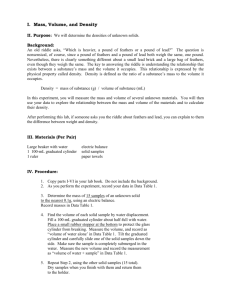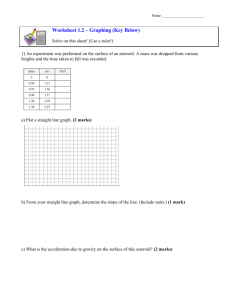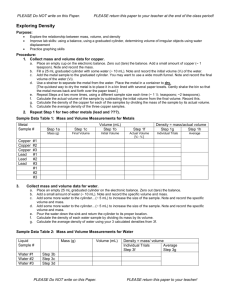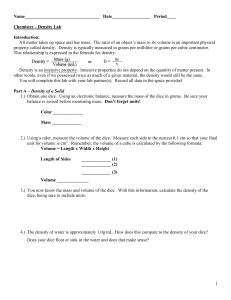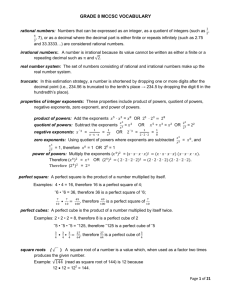Finding Density Using Graphing Techniques
advertisement
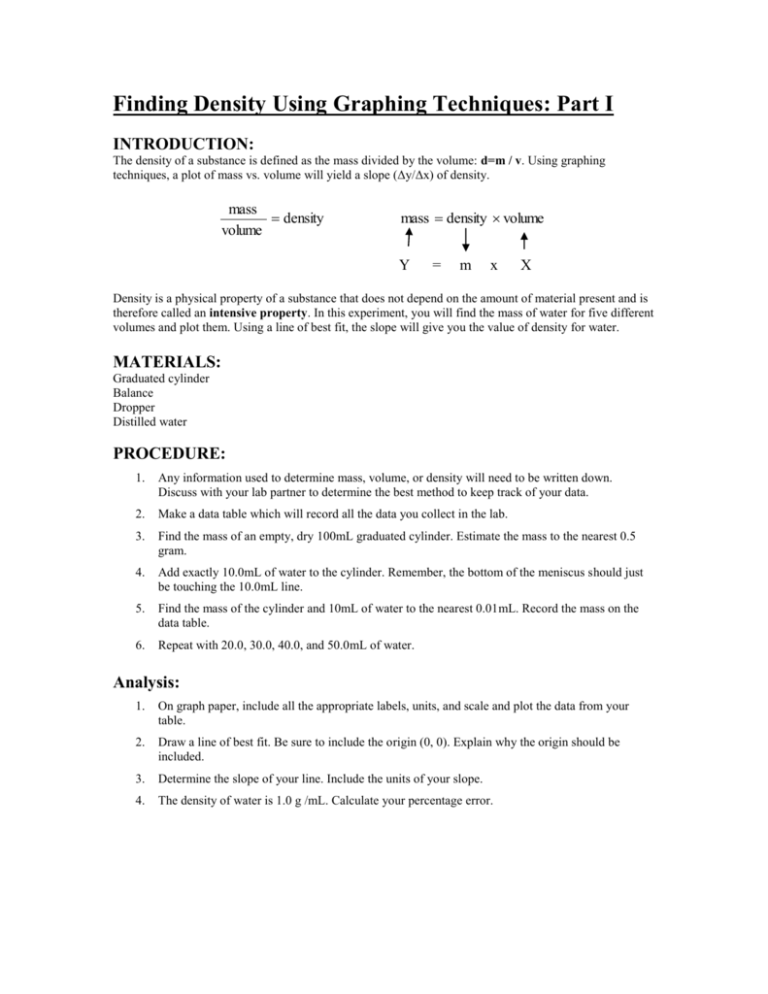
Finding Density Using Graphing Techniques: Part I INTRODUCTION: The density of a substance is defined as the mass divided by the volume: d=m / v. Using graphing techniques, a plot of mass vs. volume will yield a slope (Δy/Δx) of density. mass density volume mass density volume Y = m x X Density is a physical property of a substance that does not depend on the amount of material present and is therefore called an intensive property. In this experiment, you will find the mass of water for five different volumes and plot them. Using a line of best fit, the slope will give you the value of density for water. MATERIALS: Graduated cylinder Balance Dropper Distilled water PROCEDURE: 1. Any information used to determine mass, volume, or density will need to be written down. Discuss with your lab partner to determine the best method to keep track of your data. 2. Make a data table which will record all the data you collect in the lab. 3. Find the mass of an empty, dry 100mL graduated cylinder. Estimate the mass to the nearest 0.5 gram. 4. Add exactly 10.0mL of water to the cylinder. Remember, the bottom of the meniscus should just be touching the 10.0mL line. 5. Find the mass of the cylinder and 10mL of water to the nearest 0.01mL. Record the mass on the data table. 6. Repeat with 20.0, 30.0, 40.0, and 50.0mL of water. Analysis: 1. On graph paper, include all the appropriate labels, units, and scale and plot the data from your table. 2. Draw a line of best fit. Be sure to include the origin (0, 0). Explain why the origin should be included. 3. Determine the slope of your line. Include the units of your slope. 4. The density of water is 1.0 g /mL. Calculate your percentage error. Finding Density Using Graphing Techniques: Part II INTRODUCTION: The density of a substance is defined as the mass divided by the volume: d=m / v. Using graphing techniques, a plot of mass vs. volume will yield a slope (Δy/Δx) of density. mass density volume mass (Y) density (m) volume( X) Density is a physical property of a substance that does not depend on the amount of material present and is therefore called an intensive property. In this experiment, you will find the mass of water for five different volumes and plot them. Using a line of best fit, the slope will give you the value of density for water. MATERIALS: Graduated cylinder Aluminum Chunk Balance Distilled water PROCEDURE: 7. Any information used to determine mass, volume, or density will need to be written down. Discuss with your lab partner to determine the best method to keep track of your data. 8. Make a data table which will record all the data you collect in the lab. 9. Fill a graduated cylinder to a level which will cover the inserted metal. Record the volume to the nearest 0.5mL remembering to read the level of the meniscus. 10. Add the metal to the cylinder and record the new volume. 11. Find the mass of the metal chunk to the nearest 0.5g. 12. Repeat with all 5 chunks of metal. Analysis: 5. On graph paper, include all the appropriate labels, units, and scale and plot the data from your table. 6. Draw a line of best fit. Be sure to include the origin (0, 0). Explain why the origin should be included. 7. Determine the slope of your line. Include the units of your slope. 8. The density of water is 2.7 g /mL. Calculate your percentage error. Follow-Up: Aluminum’s density (2.7 g/mL) is higher than water’s (1.0 g/mL) and it sinks. What conclusion can you draw about a material’s density and its ability to float on a liquid?






